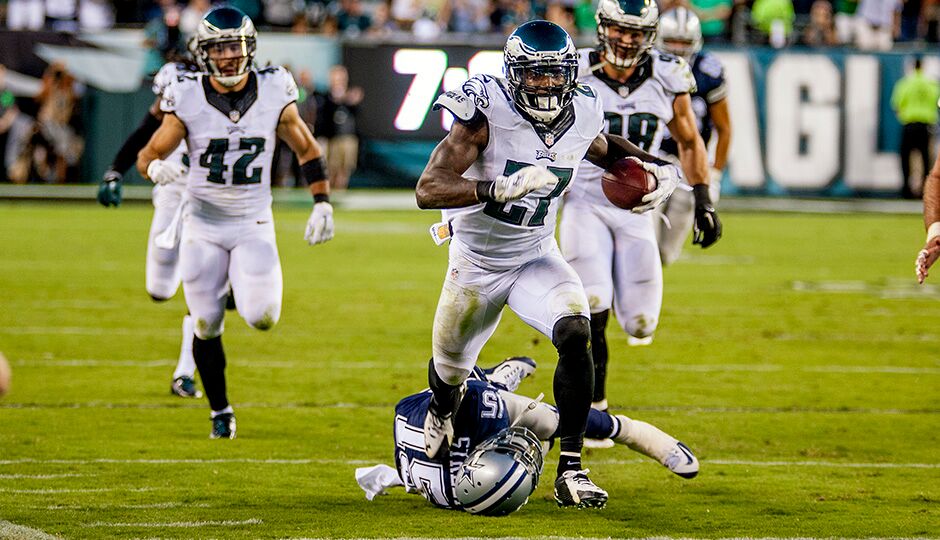Eagles Key Plays: How They Happened

Photo by: Jeff Fusco.
The Eagles gave up two touchdowns, scored once, committed three turnovers and forced two turnovers in their 20-10 loss against the Cowboys Sunday. Here’s how it all happened.
The play: Danny McCray blocked Donnie Jones’ punt, before Kyle Wilber returned it 26 yards for the first touchdown of the game.
How it happened: Dallas already ran this play earlier in the game, but Philadelphia had much more trouble this time around. McCray came through untouched after one Cowboy slanted inside and McCray and another Cowboy looped around. However, personal protector Chris Maragos couldn’t block McCray because the Cowboy who slanted inside got past Jon Dorenbos and Maragos had to block the inside rusher.
According to former referee Mike Pereira, however, Dallas’ touchdown should’ve been called back. It’s illegal to hit the punter, as the Cowboys did, in the head or neck area because he’s considered defenseless, even after a blocked punt.
Bird’s-eye view: “They ran a good twist stunt on us,” Maragos said. “All eight of us just didn’t block it up right. We have to stay tight down the middle and handle the loopers coming around. We have to make sure we play off each other and pass things off.”
The play: Jordan Hicks sacked Tony Romo and forced a fumble, which Fletcher Cox recovered.
How it happened: Even though the Eagles only rushed five defenders, the blitz Bill Davis called worked to perfection. DeMeco Ryans blitzed through the ‘A’ gap in between the left guard and center while Hicks looped around and blitzed through the ‘B’ gap in between the left guard and left tackle. The left guard picked up Ryans and the left tackle had Cox in front of him, leaving Hicks to rush Romo untouched.
Bird’s-eye view: “It was a pretty routine play, just a normal blitz,” Hicks said. “It was a cross stunt, nothing special. They just missed it.”
The play: Sam Bradford’s pass intended for Zach Ertz was intercepted in the end zone by Sean Lee.
How it happened: This was both a bad read and a bad throw by Bradford. Although it’s possible he could’ve completed the ball to Ertz if he threw it high and in stride, it would have been a difficult catch for Ertz regardless. Josh Huff was open after a shallow crossing route over the middle, and Riley Cooper was even more open on an in route in the back of the end zone.
Bird’s-eye view: “We were calling a play trying to get some man coverage, and they zoned it off,” Bradford said. “When I got back to Ertz, it looked like Sean Lee had his back turned to him so I gave [Ertz] a chance and somehow I threw it to [Lee] and he made a great play.”
The play: Byron Maxwell forced a fumble after a Dallas three-yard reception, leaving Malcolm Jenkins to scoop it up and run 34 yards.
How it happened: Defenders are often taught to make the tackle if they’re the first player to the ball and to let their teammates try to force a turnover while the ball carrier is wrapped up. However, Maxwell did a nice job spotting how loose Gavin Escobar was holding the ball so he knocked it out.
Bird’s-eye view: “We needed a play,” Maxwell said. “We were in man and I had to go across the field and get him. I saw an opportunity to get the ball out and that was it.”
The play: Bradford fumbled Jason Kelce’s premature snap and the Cowboys recovered it.
How it happened: Kelce explains why he snapped the ball before Bradford was ready below, but there was also discussion about whether a penalty should have negated the turnover. According to Pereira, however, because the Eagles weren’t set, it’s an illegal shift penalty and the ball is live.
Bird’s-eye view: “It was just real loud,” Kelce said. “I thought I heard a snap count, and obviously there wasn’t a snap count, and Sam wasn’t ready for the snap because I snapped it early.”
The play: Bradford’s pass intended for Ertz was intercepted and returned 24 yards.
How it happened: Bradford could’ve thrown the ball in front of Ertz to make it easier to catch, but the defender made a nice play by pulling Ertz’s arm down as the tight end was trying to bring the ball in. Ertz said he should’ve made the catch after the game, but that’s a tough play to make.
The play: Brandon Weeden threw a 42-yard touchdown pass to Terrance Williams, who was covered by Maxwell.
How it happened: The Eagles were in zero coverage, meaning every defensive back was in man-to-man and had no help from anyone else. Because they brought six rushers, Brandon Graham came free off the edge. Weeden threw the ball quickly, however, and Maxwell gave up inside leverage for an easy touchdown.
Bird’s-eye view: “[Maxwell] got a little wide in his alignment,” Davis said. “The technique and alignment from the get-go put him in harm’s way and then the slant ball got him and out ran him.”
The play: Bradford threw a six-yard touchdown pass to Jordan Matthews for the Eagles’ only score of the game.
How it happened: This was a perfectly thrown ball by Bradford after Matthews ran a simple out route. Matthews tried to slow the defensive back down by pushing him, but because the Cowboys were in zone, the defensive back may not have followed Matthews quicker anyway.
Bird’s-eye view: “It was a physical route,” Matthews said. “I tried to body up the corner and Sam just threw a great ball. Easy catch, easy score.”